Bronze Age Massacre
About 3200 years ago, two armies clashed at a river crossing near the Baltic Sea. Information about this collision can not be found in any book on stories: writing in this region became widespread only after 2000 years. And it was not a clash between two local clans. Thousands of warriors met here in mortal combat, perhaps on the same day, using weaponmade of wood, flint and bronze - metal, which at that time was at the top of military technology.
In an effort to gain solid footing on the banks of the Tollense River, a narrow water belt running through the marshes of Northern Germany in the direction of the Baltic Sea, the armies came together hand to hand, mutilating and killing each other with clubs, spears, swords and knives. Arrows with bronze and flint tips, produced at close range, pierced the skull and stuck deep in the bones of young men. Horse-spear-pierced horses of high rank fell into the mud. Not everyone survived the melee - some warriors mixed up, ran and were amazed from behind.
At the end of the battle, hundreds of people, dotting the swampy valley, were left lying dead. Some bodies, after everything valuable was removed from them, remained to swim in small lakes, others plunged to the bottom, which, thanks to one or two meters of water, protected them from being robbed. Gradually on the bone donkey peat. For many centuries, the battle was forgotten.
In 1996, an amateur archaeologist discovered a forearm bone protruding from a steep bank of the river - the first key to the grim mystery of the Tollense Valley, located about 120 kilometers north of Berlin. At one end of this bone, a flint tip was firmly implanted, prompting archaeologists to carry out exploratory excavations, which yielded more bones, broken skulls, and a 73 centimeter cudgel resembling a baseball bat. Radiocarbon dating of artifacts showed 1250 year BC, which made it possible to assume that we are talking about an episode from the European Bronze Age.
Now, after a series of 2009 - 2015 excavations, the researchers began to realize what the battle was and its amazing importance to the Bronze Age society. On the three-kilometer stretch of the Tollense River, archaeologists from the Mecklenburg-Front Pomerana Department of Historical Findings and the University of Greifswald dug up wooden batons, bronze spearheads, and flint and bronze arrowheads. They also discovered a huge number of bones: the remains of at least five horses and more than 100 people. The bones of a hundred more people may not be found, while thousands of others could take part in the battle and remain alive.
“If our hypothesis is true that all the finds relate to the same event, then we are dealing with a conflict of scale previously unknown to the north of the Alps,” says excavation director Thomas Terberger, an archaeologist from the Lower Saxon State Cultural Heritage Service in Hannover . "There is nothing to compare with this." This, together with weapons and warriors, may be the earliest direct evidence of a battle of this magnitude in the ancient world.
For a long time, northern Europe in the Bronze Age was regarded as a quiet backwater that was in the shadow of the more advanced civilizations of the Middle East and Greece. The bronze that appeared in the Middle East around 3200 BC took 1000 years to come here. But the scale of Tollense speaks of greater organization and greater cruelty than previously thought. “We looked at scenarios of small groups of young people killing and stealing food, but it was amazing to imagine such a major battle of thousands of people,” says Svend Hansen, head of the German Archaeological Institute of the Eurasia Department in Berlin. Well-preserved bones and artifacts add detail to the picture of development in the Bronze Age, showing the existence of a class of trained warriors and suggesting that people throughout Europe were involved in bloody clashes.
Now there is little disagreement about the fact that Tollense is something special. “When it came to the Bronze Age, we lacked solid evidence. Having opened the battlefield and the people killed on it and their weapons, ”says archaeologist Barry Molloy from University College Dublin,“ we got this evidence. ”
The hunting mansion on the lake, named Schloss Viligrad, was built at the turn of the 19th century deep in the forest, 14 kilometers north of Schwerin, the capital of the North German state of Mecklenburg-Vorpommern. Nowadays, this raw building is a home for the state department of historical heritage and at the same time a small local art museum.
In the hall with a high ceiling on the third floor of the castle, high windows overlook the foggy lake. Inside, the pale winter light draws dozens of skulls laid out on shelves and tables. In the center of the room, the long bones of the legs and short ribs lie arranged in rows on the tables, the other remains are stored in cardboard boxes, stacked on metal shelves, reaching almost the ceiling itself. Bones take up so much space that there is almost no space to walk.
When the first of these finds were dug in the 1996 year, it was still impossible to understand that Tollense was a battlefield. Some archaeologists assumed that the skeletons could have been washed away from the cemetery or that they had accumulated over the centuries.
For skepticism there were reasons. Prior to Tollens, direct evidence of large-scale battles of the Bronze Age was scanty, especially in this region. Historical narratives depict epic battles in the Middle East and in Greece, but few artifacts confirming these boastful stories have been preserved. “Even in Egypt, knowing many stories about wars, we never found sufficient archaeological evidence of their participants and sacrifices,” says Molloy. In Europe, the Bronze Age lacks even historical stories and all researchers had to deal with weapons from ceremonial burials and a small number of graves that have undeniable evidence of violence, such as decapitated bodies or arrowheads in bones. Until the 1990s, “for a long time, we didn’t represent a real prehistoric war,” says Hansen. Finds in graves were explained as prestigious objects or symbols of power, and not as a real weapon. “The majority believed that ancient society was peaceful and that men of the Bronze Age were engaged in trade, etc.,” says Helle Vandkilde, an archaeologist from the Danish University of Aarhus. "Very little was said about the war."
- Tinned rings and bronze spirals. Warriors could wear these two tin rings on their fingers. A small bronze spiral could serve as a “brush” or decoration of clothes.
-Wooden batons. Archaeologists have found two batons in Tollens, both probably belonging to people of lower rank. The simple 73 centimeter baseball bat is made of ash, and the 62 centimeter croquet mallet was made of turn.
-Bronze ax. Similar axes in the Bronze Age were used as weapons, as well as for household work. They were exchanged and even saved as value.
-Bronze bracelet. Decorated jewelry suggests that, at least, some warriors had a high status).
Everything changed the 10000 bones that are in this room — that's what was left of the losers at Tollens. They were found in dense clusters: in one cluster of 1478 bones, among them 20 skulls, located on an area of about 12 square meters. Archaeologists believe that the bodies were piled or thrown into small lakes, where the movement of water mixed the bones of different people. Considering the specificity of individual bones - skulls and hips, for example, paleontologists Utah Brinker and Annemarie Schramm identified at least 130 people, almost all men, mostly between 20 and 30 for years.
This number allows you to judge the scale of the battle. “There is at least a 130 man and five horses. And we just opened 450 square meters. This is the maximum 10% of the detected layer, maybe even 3 or 4 percent, ”says Detlef Yantzen, head of archaeologists. “If we had excavated the whole area, we could have 750 people. This is incredible for the Bronze Age. ” He and Thurberger claim that this indicates that according to rough estimates, if one of the five participants was killed and left on the battlefield, then almost 4000 people could take part in the battle.
Brinker, the paleontologist responsible for analyzing the remains, says that the moisture and chemical composition of the soil of the Tollense Valley kept the bones almost perfect. “We can reconstruct exactly what happened,” he says, lifting a rib with two tiny V-shaped cuts on the edge. “These cuts on the ribs show that he was stabbed twice in the same place. We have many of these, often with multiple marks on the same edge. ”
When scanning the bones at the Berlin Institute of Science and at the University of Rostock using microscopic computed tomography, detailed, three-dimensional images of these lesions were obtained. Now archaeologists identify the weapons that caused them by comparing the images with the scans of weapons found in Tollens or in contemporary burials from different parts of Europe. For example, the holes in the bones in the shape of a diamond definitely correspond to the shape of the bronze arrowheads found on the battlefield. (Bronze artifacts in Tollense are found more often than flint ones, possibly due to the fact that metal detectors are used to scour the area).
Bone scans also help clarify the battle picture, Thurberger says. The bone of the forearm, with the arrowhead stuck in it, the one with which the excavation of the battlefield began, on the X-ray, seems to show signs of healing. In the Antiquity article of 2011 of the year, a team of researchers suggested that the man was injured at the beginning of the battle, but was able to continue fighting for several days or weeks before he died, which may mean that the conflict was not a one-time clash, but a series battles for several weeks.
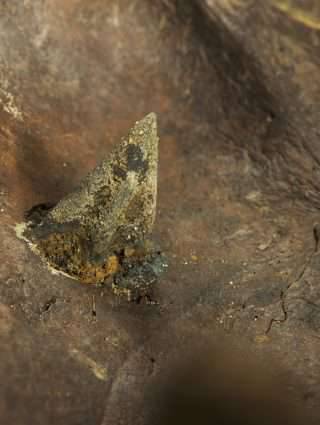
But a microscopic study told a different story: What initially looked like healing — the indistinct lines around the X-ray tip actually turned out to be a layer of broken bone, compressed by a single blow, which probably turned out to be fatal. “It made us reconsider the version that the event took place over a period of weeks,” says Thurberger. So far, there are no bodies with signs of healing wounds, which indicates the likelihood that the battle took place in one, or maximum, several days. "If we are dealing with a single event, and not with collisions for several weeks, then this greatly affects our interpretation of the scale of the conflict."
Last year in Hamburg, a team of engineers used a technique developed to simulate collisions with aircraft details in order to understand what types of strikes the warriors were subjected to. For example, at first glance, an archaeologist, the femur, broken close to the hip joint indicates a possible fall from a horse. In our time, such injuries occur among motorcyclists and riders in the fall.
But modeling tells a different story. Melanie Schwinning and Hella Harten-Bug, archaeologists and engineers from the University of Hamburg, examined the physical properties of the bronze-age bone and weapons, along with damage specimens from a fall from a horse. Experimental archaeologists also stuck reconstituted flint and bronze tips in dead pigs and examined the damage.
Schwingning and Harten-Bug say that the bronze tip of the spear, falling into the bone at an acute angle down, is able to break the femur, cutting it in half like a log. “When we modeled it, everything became more like a handgun, and not a fall from a horse,” says Schwinning. "We could even restore the power of the impact, which, in fact, is not too great." According to their estimates, a man of average build, having invested the weight of his body with a spear, could do it.
Why people gathered in this place to fight and die is another mystery that archaeological data helps to unravel. The valley of Tollense is narrow here, just 50 meters in some places. Some parts are swampy, while others have solid ground. This place could be a vanishing point for travelers crossing the North European Plain.
The 2013 geomagnetic survey of the year revealed the existence of an 120 meter bridge or a gati that ran through the valley. The structures excavated during two seasons of the excavation turned out to be made of wooden pillars and stones. Radiocarbon dating has shown that although much of the design is older than the battle time by more than 500 years, parts of it could be built or rebuilt around the same epoch when the battle took place. It is assumed that the structure could be used for centuries, being a well-known landmark.
“The crossing played an important role in this conflict. Maybe one group was trying to cross over, while the other was hindering it, ”says Thurberger. "The conflict broke out here and turned into a battle near the river."
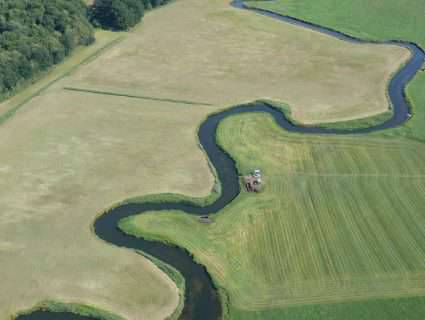
Subsequently, the winners must have thwarted everything of value from the bodies they could get to, and then threw the corpses into the shallow waters, which protected them from predators and birds. On the bones there are no traces of griping and dragging, usually left by scavengers.
All human and horse remains were under one or two meters of water in those places where the riverbed could have been in the Bronze Age. Together with these remains, gold rings were found, most likely worn in hair, spiral rings made of tin, which may have been worn on the fingers, and bronze spirals, probably decorative. The dead fell or were dumped into deep places of the river and quickly went to the bottom, where their valuables became inaccessible to robbers.
At the time of the battle, there seemed to be no cities or even small villages in Northern Europe. According to archaeologists, the local population had some connections with Scandinavia and lived large families in individual farms. The population density was less than 5 people per square kilometer. The nearest known major settlement was more than 350 kilometers south of here in Watenstedt. The landscape of that time differed little from the rural areas of modern Europe, with the exception of roads, telephones or radio.
With all this, chemical indicators show that most of the soldiers from Tollense came here from a distance of hundreds of kilometers. The isotopes in your teeth show what kind of food and water you consumed as a child, which in turn reflects the surrounding geology, being a marker of the place where you grew up. A retired archaeologist from the University of Madison (Wisconsin) Doug Price analyzed the isotopes of strontium, oxygen and carbon in thirty teeth from Tollense. Only a few of them had a typical result for the North European Plain, stretching from Holland to Poland. Other teeth came here from afar, although Price cannot yet indicate exactly where the price is. “The scatter in isotope values is really large,” he says. "We can firmly assert that the dead have come from many remote places."
Further clues came from the isotopes of another element - nitrogen, telling about the diet. Nitrogen isotopes on the teeth of several people suggest that there was a lot of millet in their diet, which at that time was more characteristic of southern, but not northern, Europe.
Ancient DNA could help uncover much more. By comparing with other samples of the Bronze Age from different places in Europe at that time, one could determine the homeland of warriors, as well as such features as eye and hair color. Genetic analyzes have just begun, but for now they support the long-range version. The DNA of the teeth suggests that some warriors are related to modern southern Europeans, and others to the inhabitants of present-day Poland and Scandinavia. "This is not a band of local idiots," said a geneticist from the University of Mainz, Joachim Burger. "This is a very heterogeneous population."
As Vandkilde of Aarhus University says: “This is an army similar to that described in Homer's epic, made up of small military units that came together to capture Troy,” an event that appears to have happened a little less than 100 years in 1184 BC All this speaks of the development of social organization, says Yantzen. “To organize a battle like this, to overcome a great distance and gather all these people in one place is a great achievement,” he says.
So far, the team has published only a small number of articles for review. Stopping the excavation, replenishing the funds, they are now busy preparing publications. But archaeologists familiar with the project claim that its value can not be overestimated. Tollense can lead to a revision of a whole historical period in the territory from the Baltic to the Mediterranean, says archaeologist Christian Christiansen of the University of Gothenburg in Sweden. “This opens the door to many new facts about how the societies of the Bronze Age were organized,” he says.
For example, there is solid evidence that this battle was not the first for those people. Twenty-seven percent of skeletons show signs of healed wounds from earlier battles, including three skulls with healed injuries. “It’s hard to tell about the reasons for these wounds, but they don’t look typical of young peasants,” says Yantzen.
The standard metal weapons and the remains of horses that were found mixed together with human bones indicate that at least some of the fighters were well equipped and trained. “These are not peasant soldiers who have fought once every few years,” says Thurberger. "These are professional warriors."
Body armor and shields appeared in Northern Europe centuries before the Tollense conflict and were to belong to the warrior class. “If you fight in armor and helmet and armor, you need daily training or you cannot move,” says Hansen. That is why, for example, the biblical David, a shepherd, refused to put on armor and a bronze helmet before a duel with Goliath. “This type of training is central to a specialized group of warriors,” says Hansen. In Tollens, these bronze-armed cavalry could be a kind of officer class leading infantrymen with simpler weapons.
But why did such significant military forces converge in a narrow river valley in northern Germany? Christiansen says that this period seemed to be a very turbulent era in the territory from the Mediterranean to the Baltic Sea. In Greece, the advanced Mycenaean civilization fell around the same time that the battle of Tollens took place. In Egypt, the pharaohs boasted victories over the "Peoples of the Sea", marauders from distant lands, plunging neighboring Hittites. And soon after Tollense, the scattered rural estates of Northern Europe were replaced by populous, well-protected settlements, formerly known only in the south. “Around 1200 BC there has been a radical change in the direction of societal and cultural development, ”says Vandkild. "Tollense comes in a period when we see war intensifying everywhere."
Tollense looks like the first step in the direction of life that still exists with us today. Starting from the scale and brutality of battles and ending with a class of warriors equipped with sophisticated weapons, these events of the distant past are connected with later and familiar conflicts. “This could be the first evidence of a turning point in social organization and military affairs in Europe,” says Vandkilde.
Outfitting warriors during the battle:
1. A spear.
Bronze spear tip.
Archaeologists have discovered this tip by the river Tollense. Wounds in the shape of a diamond, left on the bones, suggest that the warriors used such spears with great efficiency.
2. Warhorse
Small, stocky horses.
Archaeologists have discovered the remains of 5 horses on the Tollense battlefield. They are small, similar to the Icelandic horse in the photo. Warriors could ride them during a battle, or use them as pack animals. Those who possessed such animals were probably elite warrior class and had bronze weapons.
3. Clothing.
Military fashion.
The clothes of the people who died at Tollense were either stolen after the battle by robbers, or completely rotted away over thousands of years. But other rare finds of the time suggest that people probably wore raincoats and other draping clothes, like kilts, as well as leather belts. They could also wear felt hats or bronze helmets for protection.
4. Sword.
Cuts from the sword.
No swords were found on the battlefield, probably due to the fact that they were taken by robbers. But the bones found at the excavation site, similar to a rib with two cuts, suggest that the combatants used swords. Archaeologists have found a sword buried near the battlefield, because swords were included in the complex funeral rites of that time.
5. Ring for hair.
Gold rings for the hair of warriors.
These spiral gold rings, apparently used to adorn the hair, were found among the bodies of Tollense. Other Bronze Age graves contain similar rings as well as crests, which suggests that warriors, at least sometimes, had a well-groomed appearance.
6. Bow and arrows.
Deadly arrows.
Near Tollens, archaeologists have discovered many bronze arrowheads, including one stuck in the back of the skull. While rich warriors used bronze, the archers with low status, most likely, the tips were flint, also found at the excavation site.

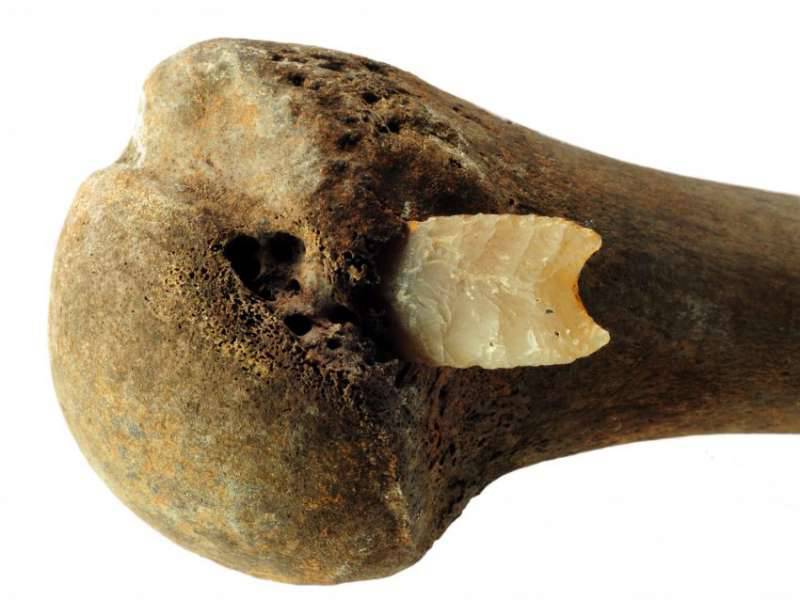
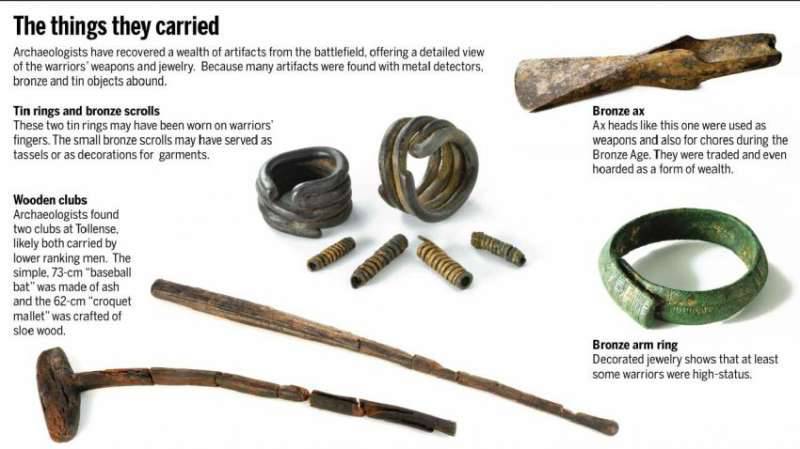
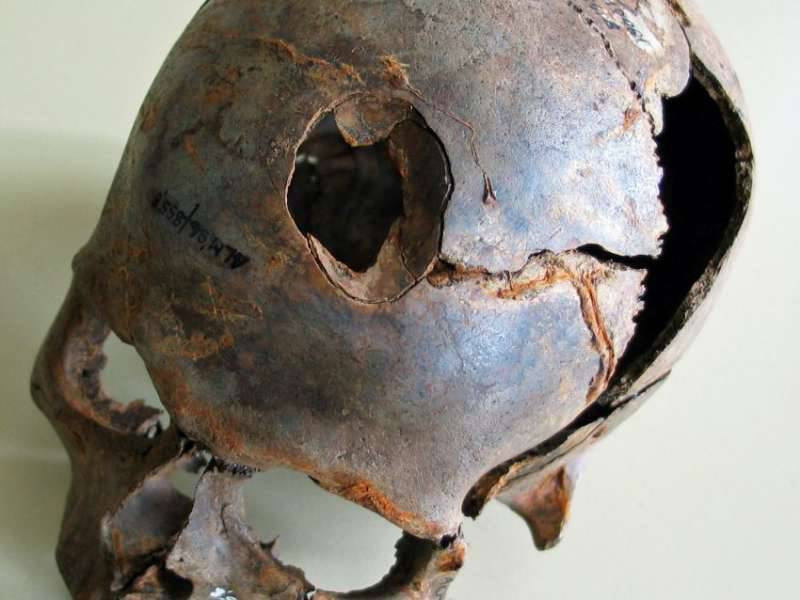
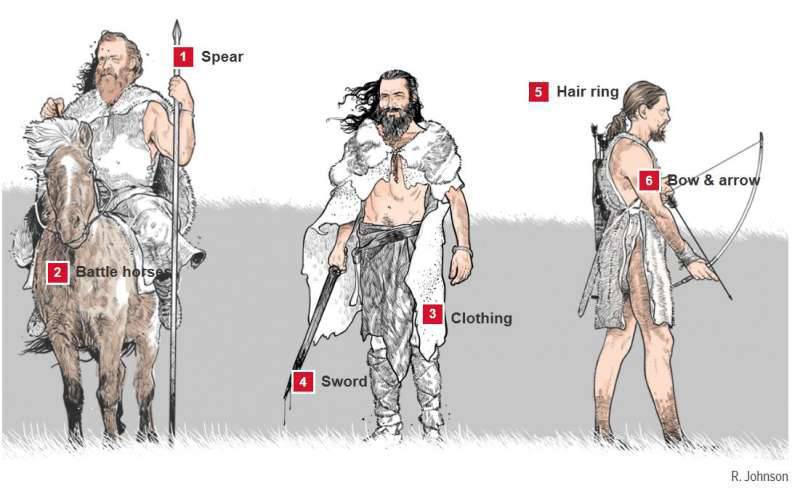
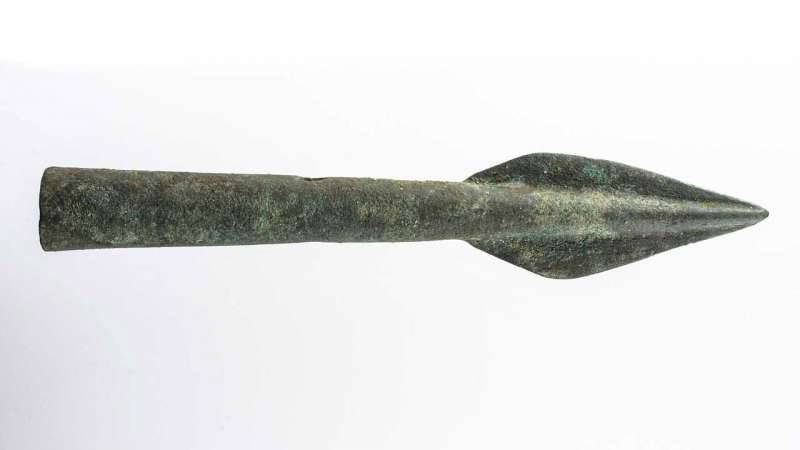

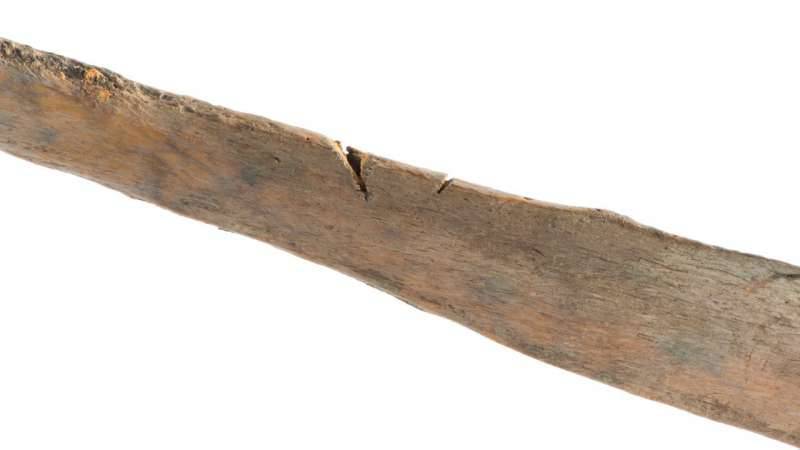
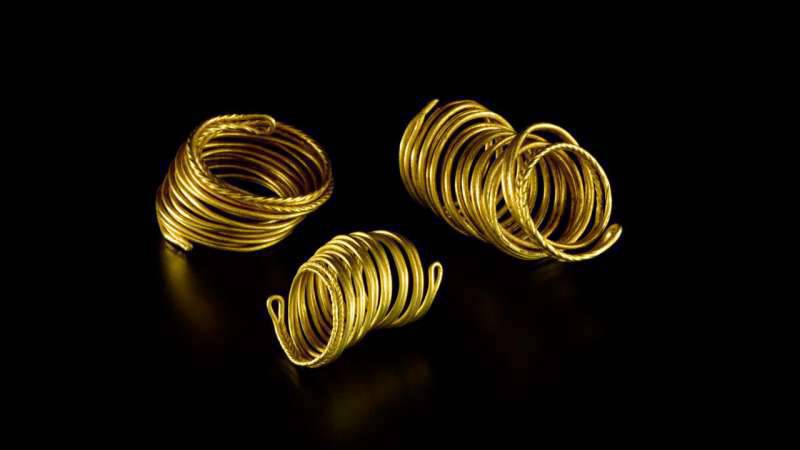
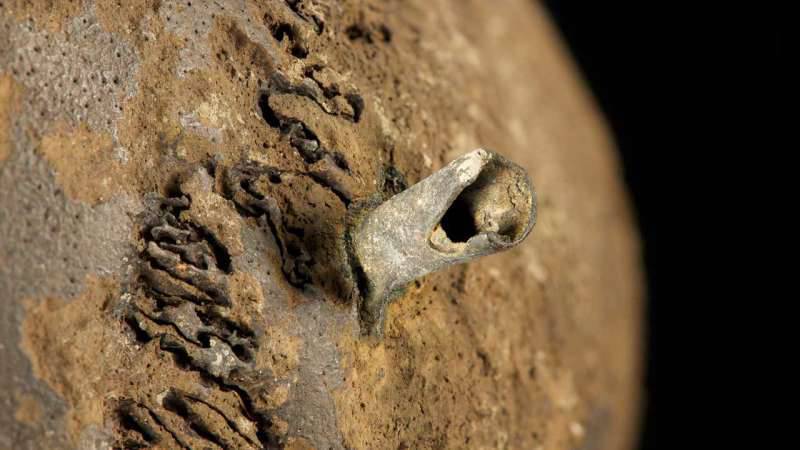
Information